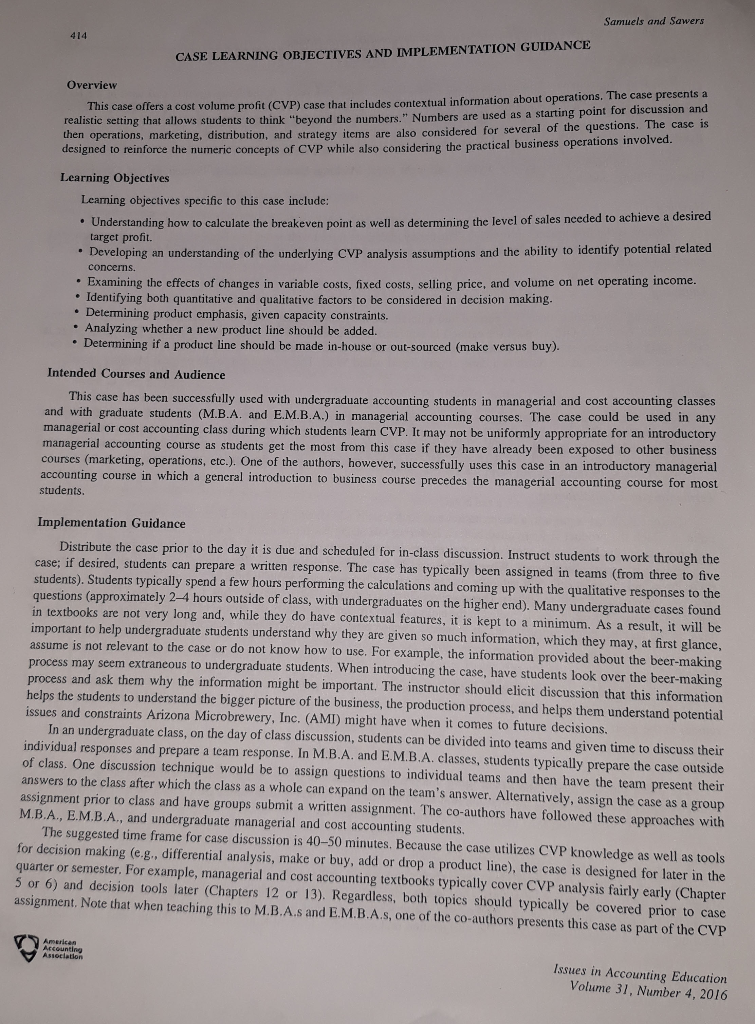
Samuels and Sawers CASE LEARNING OBJECTIVES AND IMPLEMENTATION GUIDANCE ase presents a This case offers a cost volume profit (CVP) case that includes contextual information a realistic setting that allows students to think "be then operations, marketing, distribution, and strategy items are also considered for sev designed to reinforce the numeric concepts of CVP while also considering the pr bout operations. The c yond the numbers." Numbers are used as a starting point for discussion and eral of the questions. The case i ractical business operations involved Learning Objectives Learning objectives specific to this case include ' Understanding how to calculate the breakeven point as well as determining the level of sales needed to achieve a d : Developing an understanding of the underlying CVP analysis assumptions and the ability to identify potential related Examining the effects of changes in variable costs, fixed costs, selling price, and volume on net operating income . Identifying both quantitative and qualitative factors to be considered in decision making Determining product emphasis, given capacity consraints. Analyzing whether a new product line should be added. Determining if a product line should be made in-house or out-sourced (make versus buy). Intended Courses and Audience This case has been successfully used with undergraduate accounting students in managerial and cost and with graduate students (... and E.M.B..) in managerial accounting courses. The case could be used in any managerial or cost accounting class during which students learn CVP. It may not be uniformly appropriate for an introductory managerial accounting course as students get the most from this case if they have already been exposed to other busines courses (marketing, operations, etc.). One of the authors, however, successfully accounting course in which a general introduction to business course precedes the managerial accounting course for most studen uses this case in an introductory managerial Implementation Guidance Distribute the case prior to the day it is due and scheduled for in-class discussion. Instruct students to work through ase; if desired, students can pre pare a written response. The case has typically been assigned in teams (from three to five pically spend a few hours performing the calculations and coming up with the qualitative responses to the ely 2-4 hours outside of class, with undergraduates on the higher end). Many undergraduate cases found oks are not very long and, while they do have contextual features, it is kept to a minimum. As a result, it will be raduate students understand why they are given so much information, which they may, at first glance is not relevant to the case or do not know how to use. For example, the information provided about the beer-making students). Students ty questions (approximat ant to help underg assume process may seem extraneous to undergraduate students. When introducing the cas process e, have students look over the beer-making ask them why the information might be important. The instructor should elicit discussion that this information helps the students to understand the bigger picture of the business, the production process, and helps them understand potential and issues and constraints Arizona Microbrewery, Inc. (AMI) might have when it comes to future decisions. In an undergraduate class, on the day of class discussion, students can be divided into teams and given time to discuss their individual responses and prepare a team response. In M.B.A. and E.M.B.A. classes, tudents typically prepare the case outsicd of class. One discussion technique would be to assign questions to individual teams and then have the team present their answers to the class after which the class as a whole can expand on the team's answer. Alternatively, assign the case as a group assignment prior to class and have groups submit a written assignment. The co-authors have followed these approaches with ..A., E.M.B.A., and undergraduate managerial and cost accounting students. The suggested time frame for case discussion is 40-50 minutes. Because the case utilizes CVP knowledge as well as tools for decision making (e.g., differential analysis, make or buy, add or drop a product line), the case is designed for later in the quarter or semester. For example, managerial and cost accounting textbooks typically cover CVP analysis fairly early (Chapter 5 or 6) and decision tools later (Chapters 12 or 13). Regardless, both topics should typically be covered prior to case assignment. Note that when teaching this to M.B.A.s and E.M.B.A.s, one of the co-authors presents this case as part of the CVP Acc Issues in Accounting Education Volume 31, Number 4, 2016 Samuels and Sawers CASE LEARNING OBJECTIVES AND IMPLEMENTATION GUIDANCE ase presents a This case offers a cost volume profit (CVP) case that includes contextual information a realistic setting that allows students to think "be then operations, marketing, distribution, and strategy items are also considered for sev designed to reinforce the numeric concepts of CVP while also considering the pr bout operations. The c yond the numbers." Numbers are used as a starting point for discussion and eral of the questions. The case i ractical business operations involved Learning Objectives Learning objectives specific to this case include ' Understanding how to calculate the breakeven point as well as determining the level of sales needed to achieve a d : Developing an understanding of the underlying CVP analysis assumptions and the ability to identify potential related Examining the effects of changes in variable costs, fixed costs, selling price, and volume on net operating income . Identifying both quantitative and qualitative factors to be considered in decision making Determining product emphasis, given capacity consraints. Analyzing whether a new product line should be added. Determining if a product line should be made in-house or out-sourced (make versus buy). Intended Courses and Audience This case has been successfully used with undergraduate accounting students in managerial and cost and with graduate students (... and E.M.B..) in managerial accounting courses. The case could be used in any managerial or cost accounting class during which students learn CVP. It may not be uniformly appropriate for an introductory managerial accounting course as students get the most from this case if they have already been exposed to other busines courses (marketing, operations, etc.). One of the authors, however, successfully accounting course in which a general introduction to business course precedes the managerial accounting course for most studen uses this case in an introductory managerial Implementation Guidance Distribute the case prior to the day it is due and scheduled for in-class discussion. Instruct students to work through ase; if desired, students can pre pare a written response. The case has typically been assigned in teams (from three to five pically spend a few hours performing the calculations and coming up with the qualitative responses to the ely 2-4 hours outside of class, with undergraduates on the higher end). Many undergraduate cases found oks are not very long and, while they do have contextual features, it is kept to a minimum. As a result, it will be raduate students understand why they are given so much information, which they may, at first glance is not relevant to the case or do not know how to use. For example, the information provided about the beer-making students). Students ty questions (approximat ant to help underg assume process may seem extraneous to undergraduate students. When introducing the cas process e, have students look over the beer-making ask them why the information might be important. The instructor should elicit discussion that this information helps the students to understand the bigger picture of the business, the production process, and helps them understand potential and issues and constraints Arizona Microbrewery, Inc. (AMI) might have when it comes to future decisions. In an undergraduate class, on the day of class discussion, students can be divided into teams and given time to discuss their individual responses and prepare a team response. In M.B.A. and E.M.B.A. classes, tudents typically prepare the case outsicd of class. One discussion technique would be to assign questions to individual teams and then have the team present their answers to the class after which the class as a whole can expand on the team's answer. Alternatively, assign the case as a group assignment prior to class and have groups submit a written assignment. The co-authors have followed these approaches with ..A., E.M.B.A., and undergraduate managerial and cost accounting students. The suggested time frame for case discussion is 40-50 minutes. Because the case utilizes CVP knowledge as well as tools for decision making (e.g., differential analysis, make or buy, add or drop a product line), the case is designed for later in the quarter or semester. For example, managerial and cost accounting textbooks typically cover CVP analysis fairly early (Chapter 5 or 6) and decision tools later (Chapters 12 or 13). Regardless, both topics should typically be covered prior to case assignment. Note that when teaching this to M.B.A.s and E.M.B.A.s, one of the co-authors presents this case as part of the CVP Acc Issues in Accounting Education Volume 31, Number 4, 2016







